Downloads: 7
India | Health and Medical Sciences | Volume 14 Issue 11, November 2025 | Pages: 957 - 961
Stem Cell Treatment in End-Stage Liver Cirrhosis Clinical and Biochemical Improvement in a Transplant - Advised Patient: A Case Report
Abstract: Liver cirrhosis, a progressive and irreversible condition characterized by hepatocellular dysfunction, fibrosis, and impaired regenerative capacity, is a major cause of morbidity and mortality worldwide. In advanced stages, patients frequently present with jaundice, ascites, and hyperbilirubinemia, with liver transplantation remaining the only definitive treatment. However, organ scarcity, cost, and surgical risk significantly limit its accessibility. The disease is driven by chronic inflammation, oxidative stress, and activation of hepatic stellate cells leading to fibrosis, with pro-inflammatory cytokines such as TNF-?, IL-6, and TGF-? playing central roles in disease progression. Conventional management strategies focus on symptomatic relief and suppression of inflammation, but these do not reverse underlying hepatic injury. In recent years, mesenchymal stem cells (MSCs) and MSC-derived biologics have emerged as promising therapeutic options for chronic liver disease. MSCs mediate hepatic repair through multiple mechanisms, including immunomodulation, anti-fibrotic activity, angiogenesis, paracrine signaling, and stimulation of endogenous hepatocyte proliferation. The paracrine factors secreted by MSCs-such as cytokines, growth factors, and extracellular vesicles-act on the hepatic microenvironment to suppress inflammation, attenuate stellate cell activation, and promote regeneration. Here, we report a case of a patient with advanced liver cirrhosis who was originally advised to have a liver transplantation but instead received Stem cell treatment. The patient presented with severe hyperbilirubinemia (total bilirubin: 12.30 mg/dL) prior to treatment. Following three cycles of treatments, serum bilirubin levels decreased markedly to 6.50 mg/dL after the second cycle and further to 4.60 mg/dL after the third cycle. Clinically, the patient reported improved appetite, energy, and quality of life, with resolution of jaundice. Importantly, the patient was no longer considered for immediate liver transplantation. Our findings demonstrate that Stem cell treatment may provide a regenerative and clinically meaningful alternative to transplantation by reversing liver dysfunction and improving biochemical outcomes. These observations align with emerging evidence supporting the use of MSC-based treatments in chronic liver disease.
Keywords: Liver cirrhosis, End-stage liver disease, Stem cell therapy, Mesenchymal stem cells (MSCs), Exosomes, Hepatic regeneration, Liver fibrosis, Fibrosis reversal, Cellular therapy, Regenerative medicine, Hepatic stellate cells (HSCs), Anti-fibrotic activity, Immunomodulation, Cytokines (IL-6, TNF-α, TGF-β), Growth factors (HGF, VEGF, IGF-1, EGF)
How to Cite?: Naman Somani, Divyang Patel, "Stem Cell Treatment in End-Stage Liver Cirrhosis Clinical and Biochemical Improvement in a Transplant - Advised Patient: A Case Report", Volume 14 Issue 11, November 2025, International Journal of Science and Research (IJSR), Pages: 957-961, https://www.ijsr.net/getabstract.php?paperid=SR251106134310, DOI: https://dx.doi.org/10.21275/SR251106134310
